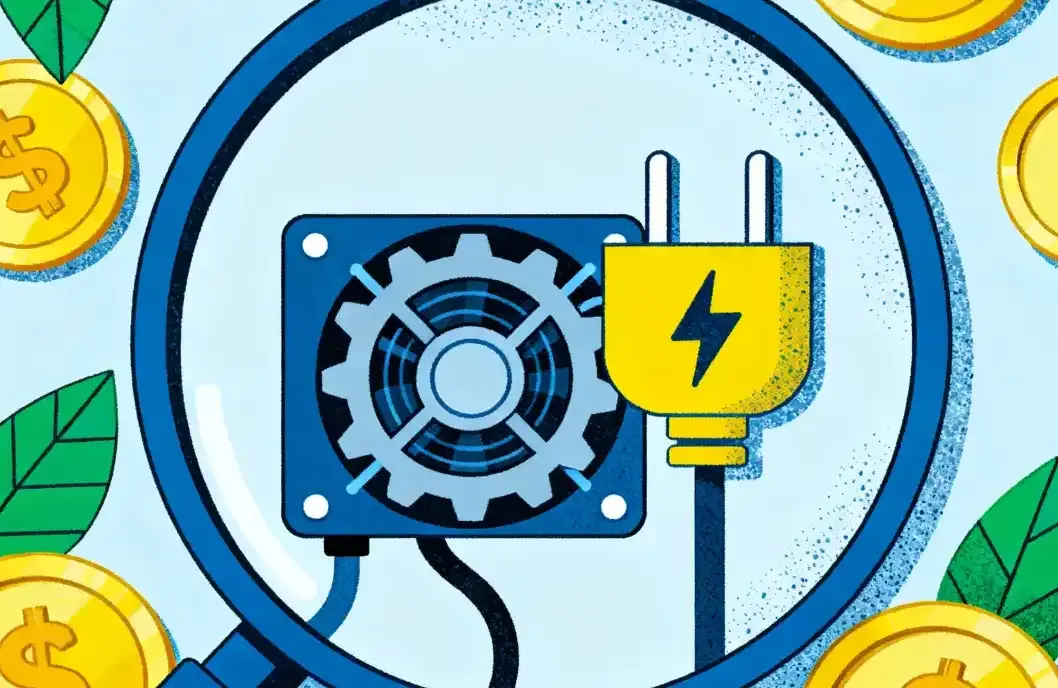The highly anticipated Meteora TGE will take place on Thursday, October 23.
Written by: Luke Leasure & Carlos
Compiled by: AididiaoJP, Foresight News
This week, Meteora is set to release its token MET: Where might its fair value lie?
Index
The week started strong, with BTC rising 7% from last Friday's low. During Monday's trading session, the Launchpad sector was the best performer, while the AI sector saw the largest decline, reversing the relative strength each had shown over the past week.
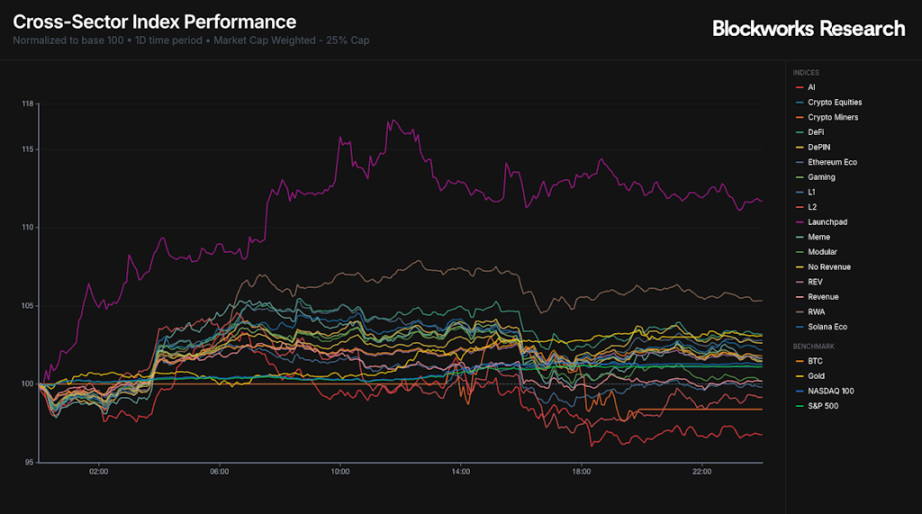
From the weekly chart, the recent strength of the Launchpad has made it a relative winner, only surpassed by gold, which again approached its historical high at Monday's close. Overall, following a historic liquidation event, most indices remain negative on a weekly basis. In the Launchpad index, the BSC-based Launchpad project AUCTION is the only asset showing positive returns on the week, up 46%.
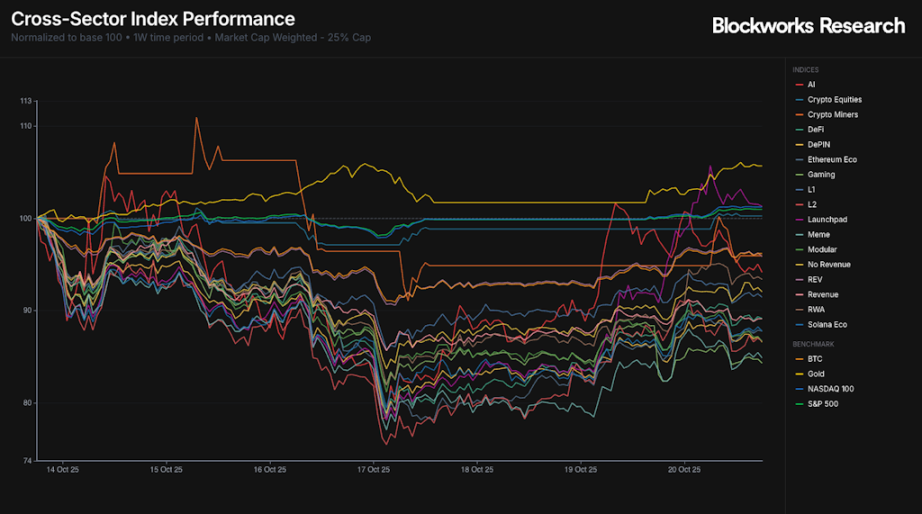
While there are some short-term gains, the monthly chart shows that almost all cryptocurrency indices have declined over the past 30 days. The liquidation event on October 10 led to widespread weakness, with only gold, cryptocurrency miners, AI, and stock indices showing strong performance.
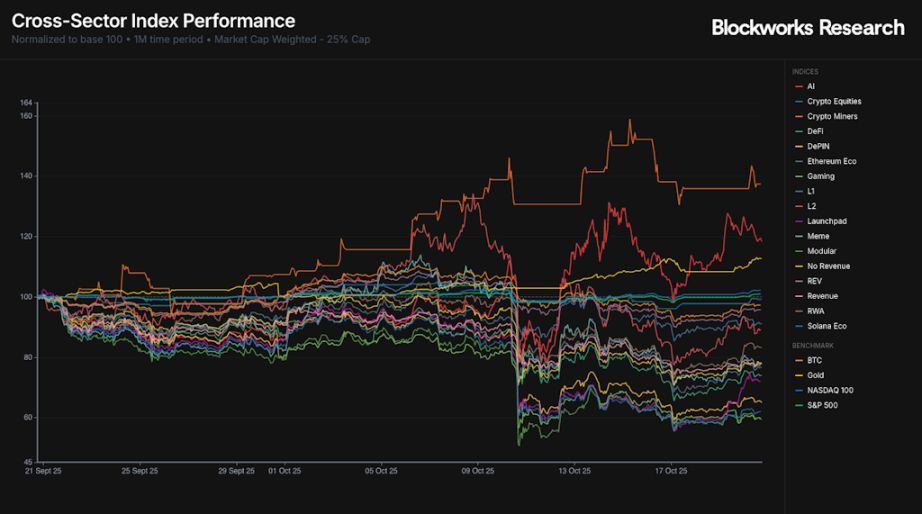
The VIX index has significantly retreated, dropping from a spike to 29 on Friday morning to 18 now. The S&P 500 and Nasdaq indices both rose during Monday's trading session, with closing prices just a step away from historical highs.
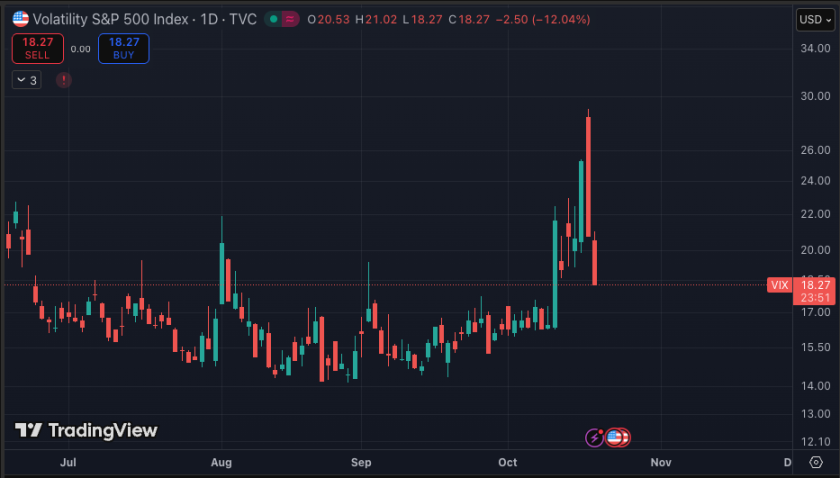
Market Update
ETF fund flows remain muted and negative. Data from Monday showed that BTC ETFs saw outflows of $40 million, ETH ETFs saw outflows of $145 million, while SOL ETFs saw inflows of $27 million. On a weekly basis, total net outflows from ETFs reached $1.5 billion, reversing some of the strong accumulation seen at the start of October. The SOL ETF is the only product showing net inflows, increasing by $14 million.
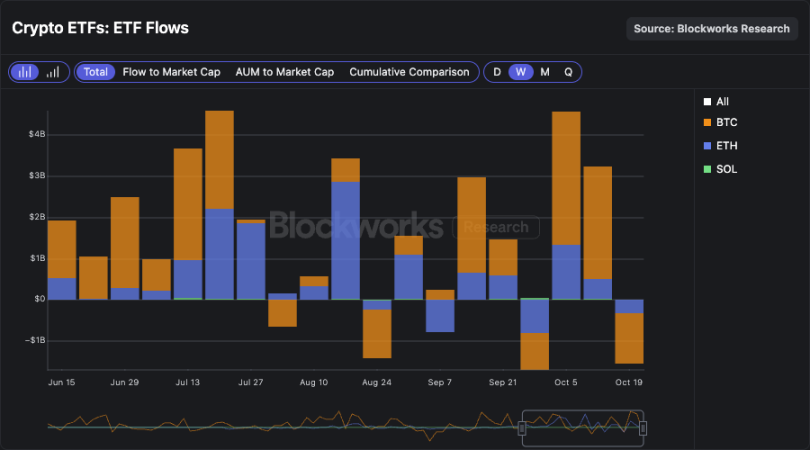
Among DATCOs, BMNR is far ahead. This entity currently holds 3,236,014 ETH, surpassing the total held by all other ETH DATCOs combined, accounting for 2.67% of the total ETH supply. Notably, since the end of August, BMNR has continuously increased its ETH holdings by nearly 70%, while most other ETH DATCOs have remained flat. In the process, BMNR's market share of ETH held in DATCOs has grown from 50% to nearly 65% now.
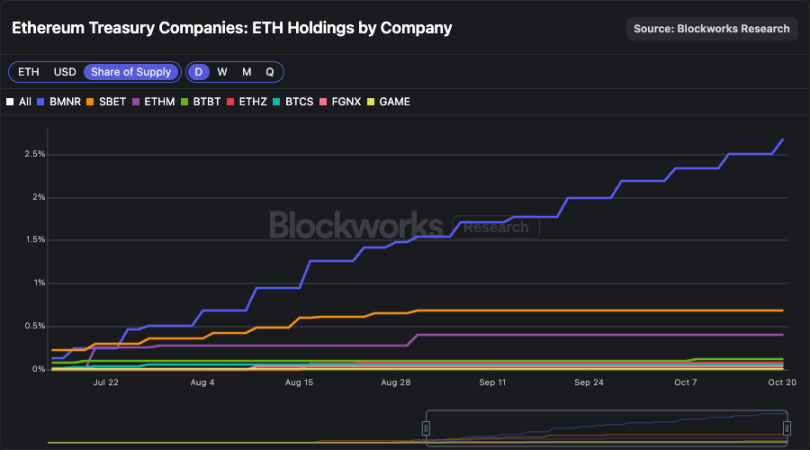
This situation is also reflected in the trading volume of ETH DATCOs. BMNR accounts for 60-85% of the trading volume of ETH DATCOs, making its stock the most liquid. This liquidity characteristic has garnered the preference of larger allocators and reduced the marginal impact of ATM issuance on prices. BMNR appears to be the clear winner in the ETH treasury company space.
In SOL DATCOs, the situation is less clear. FORD remains the largest holding entity, with nearly all of its scale obtained through PIPE issuance. Despite having authorized a $4 billion ATM issuance plan, this entity has not significantly increased its holdings through ATM issuance.
The growth in holdings remains weak, with HSDT recently rising to second place.
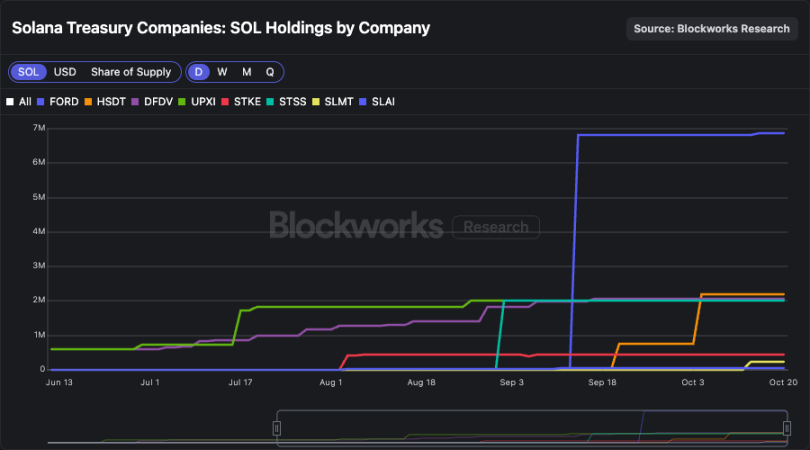
The trading volume of SOL DATCOs tells a similar story. While DFDV once dominated the trading volume in this space, the situation has now shifted to a more even distribution among top names. Although FORD holds about 43% of the SOL held by DATCOs, it accounts for only about 10% of the trading volume in the space, indicating a relatively low turnover rate for its stock. These data may well explain why the SOL accumulated through FORD's ATM issuance is very limited.
While BMNR is becoming the clear winner in the ETH space, the leader in the SOL space may still be undecided. In the coming month, trading volume is expected to increasingly concentrate on the top companies.
Meteora's TGE: What is the fair value of MET?
The highly anticipated Meteora TGE will take place on Thursday, October 23. Unlike the recent trend of projects conducting ICOs before TGE, Meteora will not raise funds prior to the TGE. Instead, it will airdrop to eligible recipients, including Mercurial stakeholders, Meteora liquidity providers, JUP stakers, and Launchpad partners. Airdrop recipients will by default receive unlocked MET or can choose to provide liquidity at launch to earn trading fees.
Meteora was launched in February 2023 by the Jupiter team, the largest DEX aggregator and perpetual contract trading platform on Solana. When Meteora launched, the previous iteration of the protocol, Mercurial Finance, was terminated. The reason for shutting down Mercurial and its governance token was the significant amount of MER involved with FTX/Alameda, leading the team to decide that the best course of action was to rebuild the platform with a new token.
As early as 2023, the team announced that 20% of MET tokens would be distributed to Mercurial stakeholders at TGE. As shown below, the team has honored its initial commitment, with 15% allocated to Mercurial stakeholders and 5% to Mercurial reserves. Additionally, the DEX has been running a points program since January 31, 2024, which will allocate a total of 15% of MET to this program. At launch, 48% of the MET supply will be in circulation, which is a high circulation ratio compared to other notable token issuances in the Solana ecosystem.
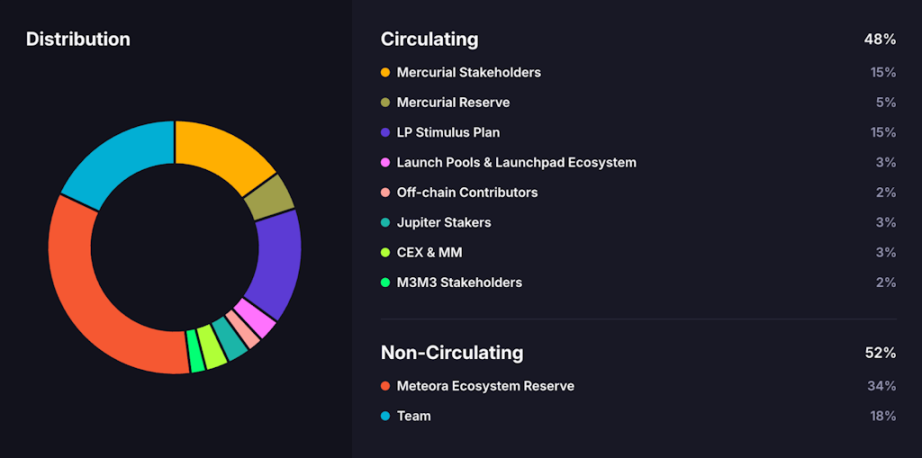
Source: https://met.meteora.ag/
As mentioned, 10% of the total supply will be used to guide initial liquidity through dynamic AMM pools, with a starting price of $0.5 and liquidity distribution extending to a $7.5 billion valuation. The early liquidity pools are one-sided, with early buyers exchanging their USDC for MET. Note that the pool fees start high and decline sharply over time through a fee scheduler.
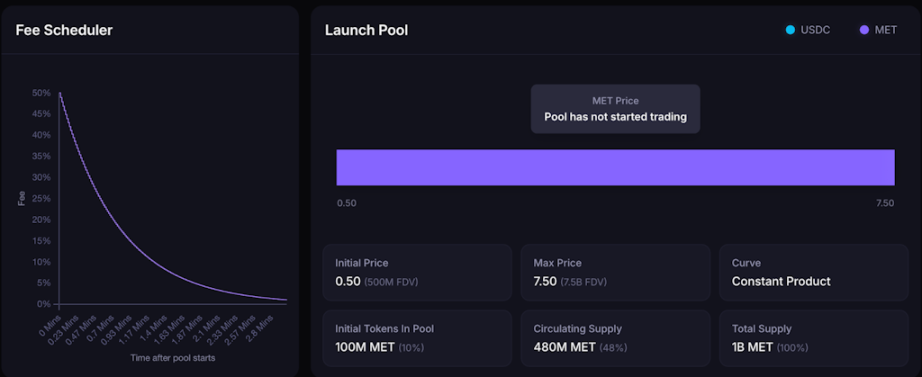
Source: https://met.meteora.ag/
Valuation Calculation
DEXs, especially on Solana, lack significant moats as they do not have front ends. A prime example of this dynamic is Raydium, which lost millions in trading volume and revenue after Pump decided to guide its graduation token to its own AMM PumpSwap. Meteora attempts to mitigate this issue through vertical integration, expanding its distribution capabilities through Jupiter and selected Launchpad partners.
As mentioned, the DEX works closely with the Jupiter team, which has become a common portal for retail users to conduct on-chain transactions. Additionally, Meteora is launching a Launchpad in August 2024 in collaboration with Moonshot and is introducing new partners over time, including Believe, BAGS, and Jup Studio. The chart below shows that recent Launchpad activities have contributed between $200,000 to $800,000 in weekly revenue to Meteora, with most of the traffic coming from Believe and BAGS.
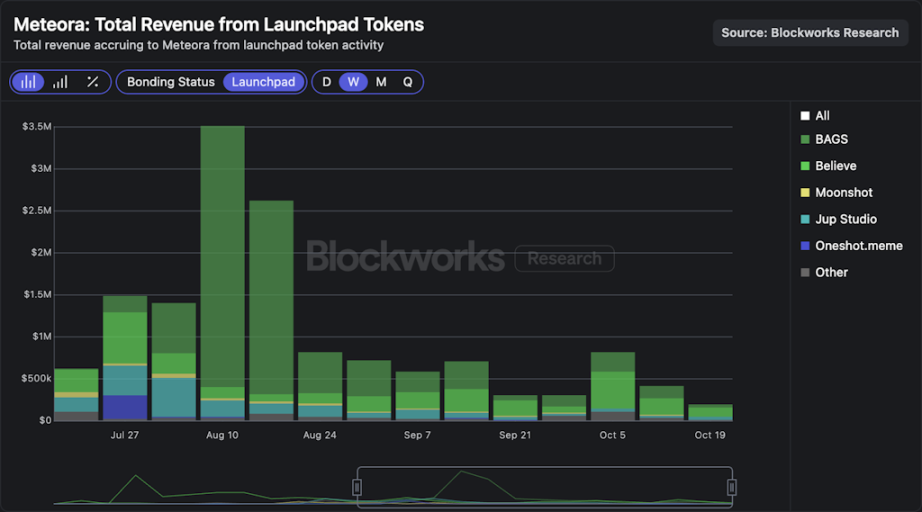
From an overall financial perspective, Meteora has generated $8.8 million in revenue from all its funding pools over the past 30 days, with weekly revenue consistently approaching $1.5 million even during periods of relatively low on-chain activity. Notably, over 90% of Meteora's revenue comes from Memecoin funding pools, which typically have higher fee levels than SOL-stablecoin, project token, LST, and stablecoin-stablecoin pools.
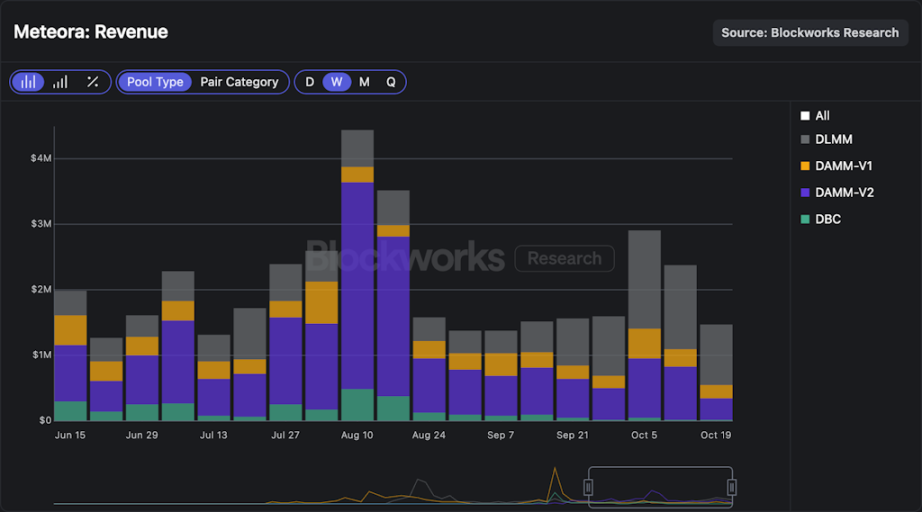
Regarding valuation, we can use Raydium and Orca as comparable companies. The chart below shows the price-to-sales ratio of RAY and ORCA year-to-date based on 30-day annualized data. We observe that until September, the pricing ratios of these two assets were relatively similar, after which RAY began to trade at a premium. From a broader perspective, the median price-to-sales ratio for these two assets in 2025 is 9 times.
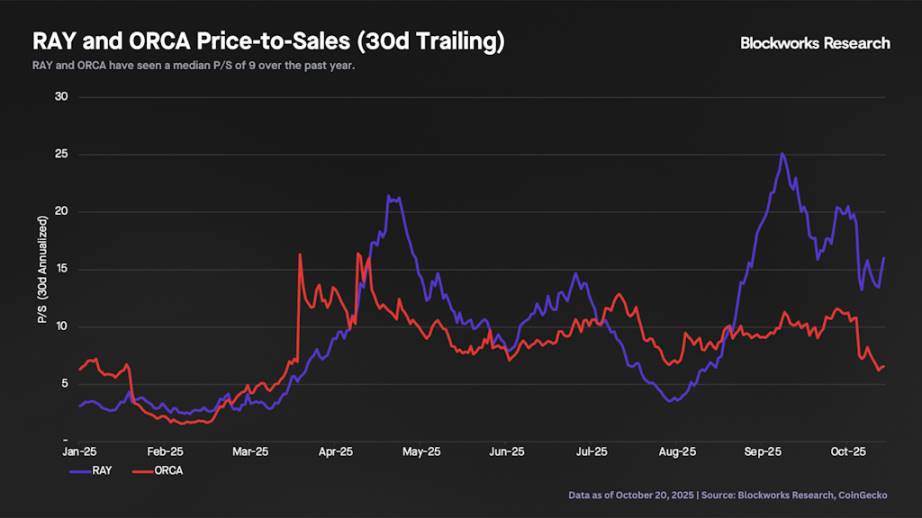
The table below compares the price-to-sales ratios of RAY and ORCA over different review periods. We observe that ORCA's trading behavior is very similar across all annualized time frames, with a price-to-sales ratio of about 6 times. In contrast, RAY has become more expensive in recent months as revenues have declined. For Meteora, we see its annualized revenue ranging from approximately $75 million to about $115 million, depending on the review period.
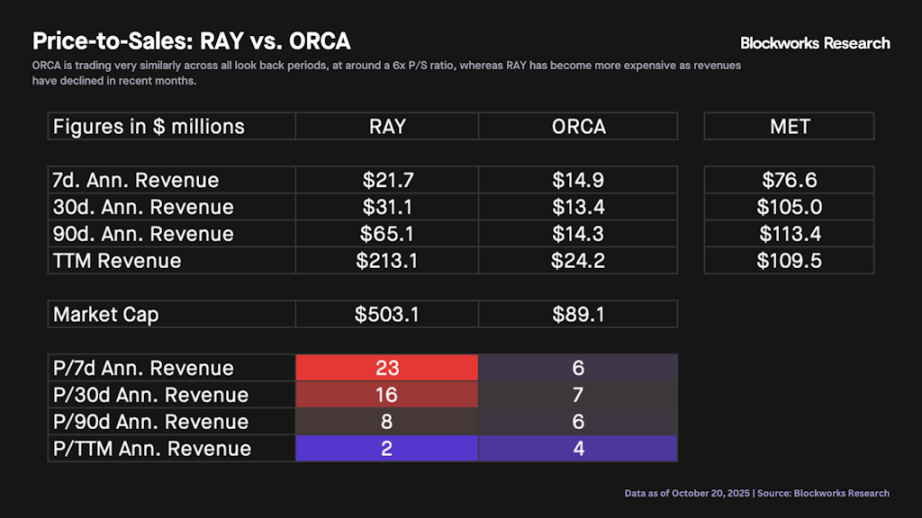
Finally, the chart below illustrates the potential valuation of MET within different revenue and price-to-sales ratio ranges. Based on the historical pricing of RAY and ORCA, a price-to-sales ratio between 6 and 10 times is most likely. Therefore, it is reasonable to expect that MET's trading valuation post-launch will be between $450 million and $1.1 billion. Note that based on these figures, a valuation exceeding $1 billion starts to appear somewhat expensive relative to comparable companies, and exceeding $2 billion would almost certainly indicate that MET is overvalued unless it can improve its revenue run rate.
免责声明:本文章仅代表作者个人观点,不代表本平台的立场和观点。本文章仅供信息分享,不构成对任何人的任何投资建议。用户与作者之间的任何争议,与本平台无关。如网页中刊载的文章或图片涉及侵权,请提供相关的权利证明和身份证明发送邮件到support@aicoin.com,本平台相关工作人员将会进行核查。




